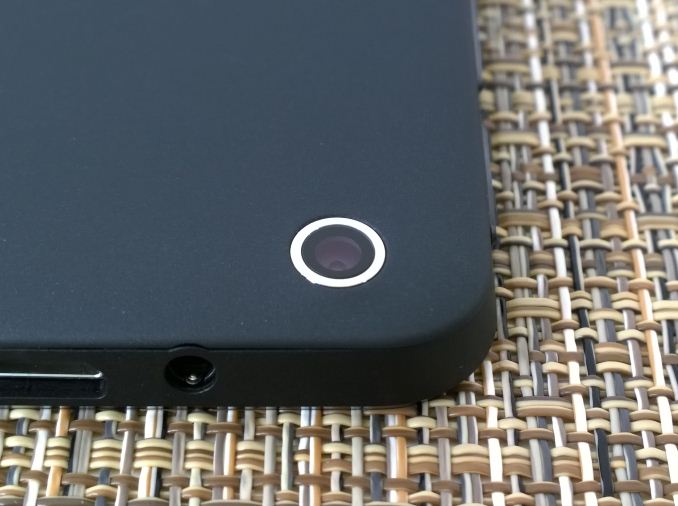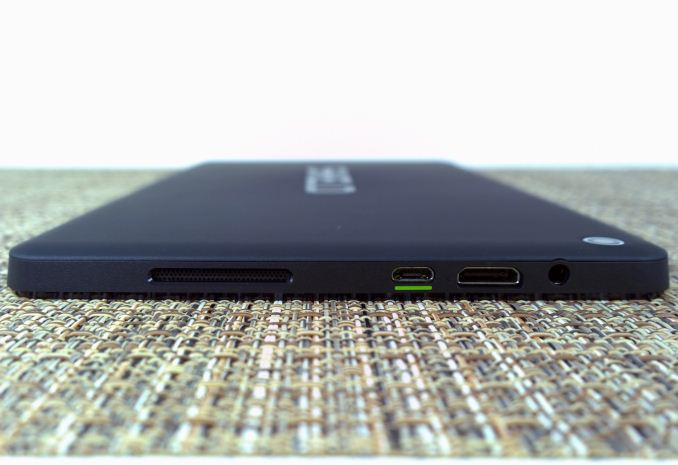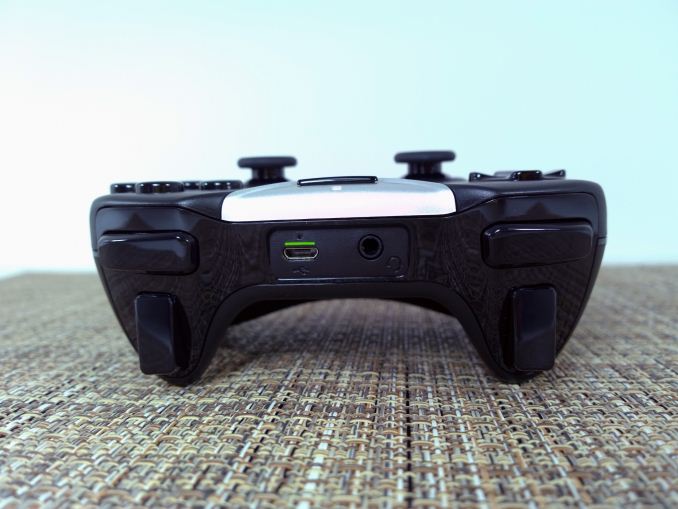The NVIDIA SHIELD Tablet Review
by Joshua Ho on July 29, 2014 9:00 AM ESTFinal Words
If I’m honest, it’s hard for me to review tablets. While I academically understand why people like tablets, I’ve never really found a use for them. They’re less comfortable to use in bed than a phone, I usually can’t type on a tablet as quickly as I do on a phone due to the size and weight, and in general it’s hard to justify a tablet when a phone is generally much more versatile. So when I got the Shield Tablet, I didn’t really know what to expect. While I have a Shield Portable, I don’t spend much time gaming on it, especially when I have a desktop that can do it much better. I came away from my experience pleasantly surprised.
Over the past five days, I’ve learned a lot about this device. As a tablet, it’s good. The material design and industrial design is acceptable and the device itself is quite ergonomic but it doesn’t blow me away. However, given the need to meet cost constraints, the matte plastic feel is really all that’s necessary and I don’t have any complaints in this area.
In the other fundamentals, we see a bit of a checkered pattern. In the display, the static contrast is quite high, and the calibration is good, but the gamut of the display doesn’t cover sRGB. This would definitely be an area that should be improved for the next generation. Although there are some compelling reasons to go with smaller color gamut, it ends up as a disadvantage when compared to other general-purpose tablets. The display is still perfectly usable, but it's a bit more washed out than I'd like.
In battery life, we see that the Shield Tablet ends up doing relatively well in web browsing, but for intensive gaming the tablet can’t spend much time away from an outlet before draining the battery completely. This is likely to be an unavoidable tradeoff, given the immense amounts of performance that Tegra K1 provides versus the power costs of doing so on a 28nm process. Anyone that has lived with a gaming laptop should understand this. As said before, it’s also possible to improve battery life from the 2.5 hour figure if the game is light enough to allow the GPU to run at lower frequencies. Barring that, NVIDIA has included options to cap the maximum frame rate of the display and reduce maximum CPU frequencies.
Otherwise the only other notable difficulty I’ve run into is with the stylus. Generally speaking it works well enough, but the stylus requires a bit more lift between words than I’m used to and keeping it from feeling fully natural. But I will be the first to admit that this is a minor issue at best.
Outside of the tablet itself, the gaming features are compelling. The larger 8” display and massively improved SoC on the Shield Tablet made for a far better gaming experience than what I had on Shield Portable. There’s a great deal of potential in ShadowPlay on a tablet, as while screen recording is nothing new in PCs this feature is often difficult to enable on Android. This is before we talk about the effects that live video encoding has on UI performance. ShadowPlay has managed to enable easy screen recording on a mobile device and do so without significantly impacting performance.
Meanwhile GameStream and GRID are even better on the larger screen that the tablet provides. While it was cool to play PC games on the Shield Portable, the size of the display simply made some elements too small to reasonably see. Now, there are no such issues. GameStream and GRID are definitely a lot of fun to use, especially if the game is well-adapted to playing on a controller.
Ultimately though, I feel that the native game library is the most important aspect of this device. While there are plenty of solid single player games, multiplayer games are few and far between. I still feel that multiplayer is where Shield has the strongest potential because it makes the difference between tens of hours per game and hundreds, even thousands of hours per game. There are definitely signs that this aspect of the ecosystem will improve in the near future as Trine 2 supports local multiplayer and War Thunder on Shield Tablet should be able to play online against console and PC players.
After getting through all of these observations over the past five days, I’ve come to realize that even though it’s not the perfect tablet, all of the features that this device brings to the table right now would be enough for me to seriously consider buying one. If NVIDIA manages to get enough multiplayer titles with an active community on Shield Tablet, there wouldn’t be a need to stop and consider at all. As someone that has spent the past few years never considering a tablet purchase at all, the Shield Tablet is the first ARM tablet that I would seriously think about buying.
The SHIELD Tablet is 299 USD for the 16GB WiFi model, 399 USD for the 32 GB LTE model. Each controller is 59.99 USD and the cover is 39.99 USD. While the 16GB model is 70 dollars more expensive than the Nexus 7 equivalent, the gap narrows to 50 dollars for the 32GB LTE model. Given the sheer amount of utility that this device brings to the table, the pricing is definitely set at the right place.














174 Comments
View All Comments
kron123456789 - Thursday, July 31, 2014 - link
Yes, you can use your Xbox360 controller with that tablet.LedHed - Wednesday, July 30, 2014 - link
When is NVIDIA going to start putting competitive SSD's inside of their mobile devices?baii9 - Wednesday, July 30, 2014 - link
Any comparison with a bay trail win8.1 tablet?nicolapeluchetti - Thursday, July 31, 2014 - link
Am i the only one who doesn't see the point of a gaming tablet with only 2.5 hours of battery when playing games?The need of a tablet for gaming is more related to situations where you have to play for lots of time without charging. I know that you can dial down the graphics and save the battery, but then where are the difference from an iPAd Air (which also has many more games?). This is totally pointless for me, it could have been good if battery lasted 5-6 hours, like it is know it's pointless.hahmed330 - Thursday, July 31, 2014 - link
If you run an ipad air full blast the batteries will last for 2.5 hours only... This is what they did.. If you run say dead trigger 2 or something like that the battery would last per say 4-5 hours.. That's pretty damn impressive by the way... I really hope this is successful as I would love play some really nice games..semi177 - Friday, August 1, 2014 - link
the comments on this site used to be good to read. now i just see bashing and misinformed comments. The admin should consider pushing down fanboy war threads much lower down and keep the useful ones on top.TheinsanegamerN - Monday, August 4, 2014 - link
Anybody know where the 32GB tablet is, or when it will release? not even nvidia shows it as available on their website, nor even mentions it.scbundy - Thursday, August 7, 2014 - link
So much for Charlie D's prediction that the Tegra K1 was going to be super hot, have a huge heatsink and use 50W.Azurael - Friday, August 8, 2014 - link
It's a bit of a disappointment in the display department, much like the Tegra Note 7 (which uses exactly the same display as the original Nexus 7 with a marginally better calibration as far as I can see) The stylus is great (in fact, I prefer it to the Wacom-developed screen in the Galaxy Notes) as is the SoC performance and value proposition - but if they want to appeal to people other than gamers (I would certainly have bought this), they've got to work on that LCD. I skipped the Nexus 5 and bought a G2 despite objecting to its size because the N5 LCD was a massive step backward in contrast from that in the Nexus 4 when calibrated. I bought a 2013 Nexus 7 to replace my 2012 Nexus 7 a few weeks ago because the LCD in the otherwise great Tegra Note is not a step forward. When will device manufacturers other than Apple realise that people do care about the LCD?sandy105 - Tuesday, April 28, 2015 - link
I have both the tegra note 7 and nexus 7 2012 .The one on nexus 7 has bonded fused display while the touch layer and screen are separated on tegra note7 making it very poor and VERY reflective.It also has muted colors and looks washed out.